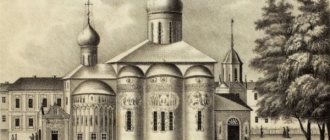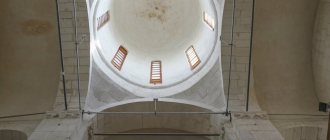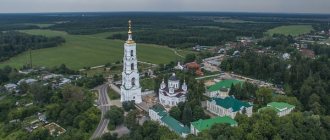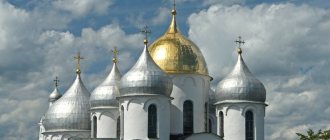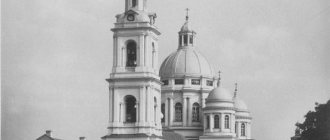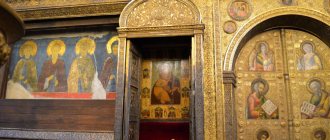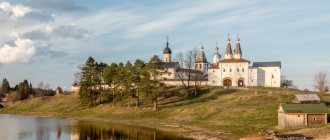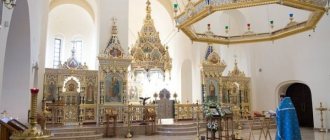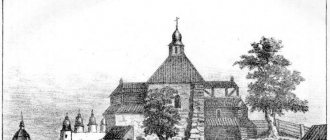Mir
Russia Moscow Spassky Cathedral of the Andronikov Monastery Map loading in progress...
{"format":"leaflet","minzoom":false,"maxzoom":false,"limit":50,"offset":0,"link":"all","sort":[""], "order":[],"headers":"show","mainlabel":"","intro":"","outro":"","searchlabel":"\u2026 \u0441\u043b\u0435\ u0434\u0443\u044e\u0449\u0438\u0435 \u0440\u0435\u0437\u0443\u043b\u044c\u0442\u0430\u0442\u044b","default":"","import-annotation":false,"width ":"auto","height":"350px","centre":{"text":"","title":"""link":"""lat":55.74925799999999753708834759891033172607421875,"lon": 37.67082400000000319550963467918336391448974609375,"icon":""},"title":"","label":"","icon":"","lines":[],"polygons":[],"circles":[ ],"rectangles":[],"copycoords":false,"static":false,"zoom":8,"defzoom":14,"layers":["OpenStreetMap"],"image layers":[] ,"overlays":[],"resizable":false,"fullscreen":true,"scrollwheelzoom":true,"cluster":false,"clustermaxzoom":9,"clusterzoomonclick":true,"clustermaxradius":80, "clusterspiderfy":true,"geojson":"","clicktarget":"","showtitle":true,"hidenamespace":false,"template":"","userparam":"","activeicon": "","pagelabel":false,"ajaxcoordproperty":"","ajaxquery":"","locations":[{"text":"\u003Cb\u003E\u003Ca href=\"/palomnik/%D0% A1%D0%BF%D0%B0%D1%81%D1%81%D0%BA%D0%B8%D0%B9_%D1%81%D0%BE%D0%B1%D0%BE%D1%80_% D0%90%D0%BD%D0%B4%D1%80%D0%BE%D0%BD%D0%B8%D0%BA%D0%BE%D0%B2%D0%B0_%D0%BC%D0% BE%D0%BD%D0%B0%D1%81%D1%82%D1%8B%D1%80%D1%8F\" title=\"\u0421\u043f\u0430\u0441\u0441\u043a\u0438\ u0439 \u0441\u043e\u0431\u043e\u0440 \u0410\u043d\u0434\u0440\u043e\u043d\u0438\u043a\u043e\u0432\u0430 \u043c\u043e\u043d\u 0430\u0441\u0442\u044b\u0440\ u044f\u003E\u0421\u043f\u0430\u0441\u0441\u043a\u0438\u0439 \u0441\u043e\u0431\u043e\u0440 \u0410\u043d\u0434\u0440\u043e\ u043d\u0438\u043a\u043e\ u0432\u0430 \u043c\u043e\u043d\u0430\u0441\u0442\u044b\u0440\u044f\u003C/a\u003E\u003C/b\u003E\u003Chr /\u003E\u003Ca href=\"/palomnik/ %D0% A1%D0%B2%D0%BE%D0%B9%D1%81%D1%82%D0%B2%D0%BE:%D0%90%D0%BD%D0%BD%D0%BE%D1%82 %D0%B0%D1%86%D0%B8%D1%8F\" title=\"\u0421\u0432\u043e\u0439\u0441\u0442\u0432\u043e:\u0410\u043d\u043d\u043e\u0442\ u0430\u0446\u0438\u044f\»\u003E\u0410\u043d\u043d\u043e\u0442\u0430\u0446\u0438\u044f\u003C/a\u003E: \u043f\u0440\u0430\u043 2\u043e\u0441\u043b \u0430\u0432\u043d\u044b\u0439 \u0445\u0440\u0430\u043c, \u043f\u0430\u043c\u044f\u0442\u043d\u0438\u043a \u0440\u0430\u043 d\u043d\u0435\u043c\u043e\ XV \u0432\u0441\u043a\u043e\u0439 u0435\u043a\u0430. \u042f\u0432\u043b\u044f\u0435\u0442\u0441\u044f \u0434\u0440\u0435\u0432\u043d\u0435\u0439\u0448\u0438\u043c \u0447\u0430\ u0441\u0442\u0438\u0447\u043d \u043e \u0441\u043e\u0445\u0440\u0430\u043d\u0438\u0432\u0448\u0438\u043c\u0441\u044f \u043f\u0440\u0430\u0432\u043e\u0441\ u043b\u0430\u0432\u043d\u044b \u043c \u0445\u0440\u0430\u043c\u043e\u043c \u041c\u043e\u0441\u043a\u0432\u044b \u0437\u0430 \u043f\u0440\u0435\u0434\u043 5\u043b\u0430\u043c\u0438\u041c """title":"\u0421\u043f\u0430\ u0441\u0441 \u043a\u0438\u0439 \u0441\u043e\u0431\u043e\u0440 \u0410\u043d\u0434\u0440\u043e\u043d\u0438\u043a\u043e\u0432\u0430 \u043c \u043e\u043d\u0430\u0441\u0442 \u044b\u0440\u044f","link":"","lat":55.74925799999999753708834759891033172607421875,"lon":37.670824000000003195509634679183363914489 74609375,"icon":""}],,"imageLayers":[]}
55.749258; 37.670824
Russia, Moscow, Andronevskaya square, 10с5
Moscow
Russia
Telephone:
+74959114502
Phones:
(495) 678-14-67, 678-14-89
Spassky Cathedral of the Spaso-Andronikov Monastery
- Orthodox church, a monument of early Moscow architecture of the 15th century. It is the oldest partially preserved Orthodox church in Moscow outside the Moscow Kremlin.
History[edit]
According to hagiographic sources, the monastery was founded in 1357. After the fire of 1368, in which the original wooden cathedral of the Andronikov Monastery burned down, a wooden Spassky Cathedral with a plinth floor was built on the site of the modern cathedral, a fragment of which was discovered during excavations in 1993. There is an assumption that the preserved white stone reliefs with fragments of zoomorphic and plant compositions, archaic in their style and design, indicate the existence of a stone temple on the territory of the monastery, built between 1360-1380. Between 1390 and 1427, the Spassky Cathedral was rebuilt again, and the white stone church of that time has survived to this day. It is a single-domed, four-pillar, three-apse temple. Andrei Rublev and Daniil Cherny participated in the painting of the cathedral (only fragments of floral patterns on the window slopes have survived from the original frescoes).
The inventory of 1763 speaks of the existence of a porch in the cathedral with a sacristy chamber in it, to the left of the western doors. In 1779, the architect Yakovlev reported on the need to renew the mural painting and amend the iconostasis in the cathedral, and also found it necessary to break through a window on the western side and two windows below between the church and the porch and add a porch on the northern side, similar to the one that already surrounded the temple on the southern and western sides.
In the 19th century, the cathedral underwent significant changes, which began with the partial restoration of the destruction that occurred in 1812, about which the then rector of the monastery, Archimandrite Feofan, reported the following:
“In the cathedral monastery church, created around 1360 by Saint Alexy Metropolitan, after its robbery, the iconostasis and so on were lit; from which the vaults with their heads fell inside the temple...”
In 1813, under the supervision of the architect Zhukov, the cathedral's vaults were corrected and an iron roof was installed; in 1818-1820, a new iconostasis was made; in 1837, the painter L. Zhukov painted the cathedral inside and out, and in 1846-1850, according to the design of the architect P. Gerasimov, the porches were rebuilt, two chapels were built to the north and south of the cathedral, a hipped roof was built over it, and significant alterations were made inside the building.
In 1934, in connection with the proposed demolition of the entire Spaso-Andronikov Monastery, the monument was measured, examined by the architect P. N. Maksimov, and a restoration project was drawn up. The work on this monument published in 1940 by the Academy of Architecture finally gave everyone a clear idea of the architectural value of the Spassky Cathedral.
In 1959-1960 The cathedral building was reconstructed in its original forms according to the design of L. A. David and S. S. Podyapolsky. However, the reconstruction of the lost upper part of the temple (the number of kokoshniks at the base of the drum, the shape of the dome, the proportions of the drum) and the pre-portal staircases remains controversial.
Since 1993, archaeological excavations have been carried out, as a result of which the ancient throne of the Spassky Cathedral and the oldest burials attributed to the founders of the Spaso-Andronikov Monastery - Andronik of Moscow and Savva of Moscow - were discovered.
There are churches (for example, the Cathedral of the Nativity of the Blessed Virgin Mary of the Nativity Monastery in Moscow) built in the likeness of the Spassky Cathedral of the Andronikov Monastery. These analogies make it possible to date the Spassky Cathedral either to the beginning of the 1390s, or to the period 1425-1427, that is, either the first or the last in a series of stylistically and structurally similar Moscow churches. The absence of mention of stone construction in the life of Sergius of Radonezh allows us to consider the dates 1425-1427 as the most probable.
Singing school and icon painting workshop
Today, not only divine services are held on the territory of the temple. Under him, there is a school of Znamenny singing - this is the main and oldest type of ancient Russian church singing, which still exists today. That's great rarity. The cathedral also has its own choir, which came to listen to Rachmaninov.
With the blessing of Patriarch Alexy II, the famous tradition of the Spaso-Andronikov Monastery - Znamenny singing - was restored in the Spassky Church in 1990. And now all services are celebrated with the statutory monophonic (unison) znamenny chant.
The church has an icon painting workshop and active publishing activities. On the basis of the monastery, church books are printed, which tell about the history and traditions of the cathedral.
Shrines[edit]
The main shrine of the monastery is the founding icon - the Image of the Savior Not Made by Hands, before which Saint Alexy made a vow during a storm to build the monastery. For about eight decades, the image was considered lost, and only in 1999 was it found in the storerooms of the Historical Museum in the Novodevichy Convent. Currently, the Spassky Cathedral has a list of this shrine.
Image of the Savior Not Made by Hands
With the revival of the parish, an icon of the Venerable Andronik and Sava of Moscow Wonderworkers was found. The rector of the cathedral, Archpriest Vyacheslav Savinykh, looking through the handwritten journal “Andronikovsky Collection” from the late 1920s in the library of the St. Danilov Monastery, found in it a photograph of that same icon with the mark “Church of the Jerusalem Metochion.” The author of the “Collections,” priest Sergius Dubrovin, later Archimandrite Andronik, signed his articles as “Rector of the Church of the Jerusalem Metochion.” The rector of the Spassky Cathedral and parishioners turned to the Church of the Resurrection of the Holy Jerusalem Metochion on Arbat and in its vaults they discovered an icon of the first abbots of the Spaso-Andronikov Monastery. Most likely, Father Sergius at one time saved more than one icon of the ruined monastery, transferring them to the Church of the Resurrection of the Word, which was never closed. On November 17, 1996, the icon was solemnly handed over to the community of the Spassky Cathedral. After restoration, it took its place in the temple.
In the arches of the altar windows, details of frescoes from the time of St. Andrei Rublev have been preserved.
Of particular note is the discovery of six holy relics during excavations in the altar of the Spassky Cathedral. In 1993, during construction work on the foundation of the throne, they discovered the base of an ancient throne with a particle of incorruptible relics in a decayed wooden ark and two pairs of parallel burials. Two coffins were located closer to the foundation of the north side of the apse, and two hollowed out logs were closer to the foundation of the south side. According to eyewitnesses, the holiness of the relics was evidenced by a wonderful fragrance, which, when the decks were opened, appeared and disappeared in waves. People who did not know that the discovery of relics was taking place behind the altar barrier in the excavation site noticed a fragrance at the entrance to the temple and turned to the archaeologists with the question: “What kind of oil did you spill there?”
Along with the relics, the accessories of the monastic vestments were preserved: a paraman (a woven leather cross encircling the monk’s body), plesnitsy (leather shoes), a leather belt with a metal buckle.
Architectural ensemble of the cathedral
In 1947, the Spaso-Andronikov monastery received the status of a nature reserve, and the architectural ensemble included the surviving buildings:
- The white stone Cathedral of the Holy Image of the Savior Not Made by Hands of the Spaso-Andronikov Monastery, one of the oldest buildings in the city (restored in forms close to the original in 1959-1960). It is an example of ancient Russian architecture.
- Refectory chambers erected on the territory during the reign of Ivan III (1504-1506).
- Stone walls and towers built in the 17th – 18th centuries.
- Two-story building of the Rector's chambers (1690).
- Three-tiered Church, illuminated in the name of Archangel Michael. Initially, a two-tier refectory was built, with household services located on the first tier. Later, in the 90s of the 17th century, on the initiative of Queen Evdokia, construction of a church began near the refectory. The building was made in the Baroque style, but the architects managed to combine the style with the refectory, combining the two buildings with one cornice. However, due to the disgrace and exile of the queen, work was suspended, and only in 1739 the church was consecrated. The temple was restored in 1960; it houses the family tomb of the Lopukhins.
- The building of the fraternal building (1763). It was originally intended to house monks. Nowadays the museum depository is located here.
- Theological school building (1810-1814). Classes for church ministers were held here, and about 100 students were trained at the same time. Now used for museum departments.
According to experts, not a single temple building has such perfect proportions. The size of the monastery influenced other temple buildings; the whole composition looks very harmonious.
Pilgrim[edit]
Current schedule of services on the official website
On the territory of the monastery there is the Central Museum of Ancient Russian Culture and Art named after. Andrey Rublev.
In the oldest architectural monument of Moscow, the Spassky Cathedral (20s of the 15th century), frescoes by Andrei Rublev, the great icon painter of Ancient Rus', were preserved in the window openings of the altar. He was a monk in this monastery and was buried here in 1430.
Address:
105120, Moscow, Andronevskaya square, 10
Phones:
(495) 678-14-67, 678-14-89
Operating mode:
Monday-Tuesday, Friday-Sunday - from 11.00 to 18.00, ticket office - until 17.15. Thursday - from 14.00 to 21.00, ticket office - until 20.15. Wednesday and last Friday of the month
Where is the Spaso-Andronikov Monastery located?
Address of the monastery: 107120, Moscow, Andronevskaya square, 10 (metro station “Ilyich Square”). It is located on the territory of Moscow on Andronevskaya Square. If you are not local, then we will help you figure out how to get there. So, first get to the Imeni Ilyich metro station. Next, you need to walk or drive one stop along Sergius of Radonezhsky Street towards the center to Andronevskaya Square and turn right.
Come to the monastery and send your prayers to the Lord with sincere faith.
May the Lord protect you!
You will also be interested in watching a video about the holy monastery:
Briefly about the main thing
- — The most probable year of foundation of the monastery is 1357.
- — In 1380, the monks met the army of Dmitry Donskoy, who returned victorious from the battle on the Kulikovo Field.
- — The monastery served as the ancient “Ivan the Great” in the Kremlin. Emperor Paul I moderated the ardor of the builders. As a result, its height was 72.5 meters (the Ivan the Great bell tower was raised to a height of 81 meters during the reign of Boris Godunov - in 1600).
- — On the territory there is a cenotaph (a tombstone without remains) to the founder of the Russian Theater Fyodor Volkov.
Just below the Kremlin
The monastery has an amazing chronicle. Here Andrei Rublev accepted monasticism: he painted icons and painted churches, and was buried here. These stones remember Sergius of Radonezh, Dmitry Donskoy and many other iconic personalities.
When we talk today about the Spaso-Andronikov monastery as a Moscow monastery, we must remember that at the time of its foundation Moscow was somewhere far away. Initially, the location for the monastery was chosen not without military intent: the high bank of the Yauza, the junction of two strategic roads: to Vladimir and through Ryazan to the Horde.
Its walls could not stop the hordes of barbarians, but the monks coped with the role of a lookout point: they warned Muscovites about trouble. And they themselves have been the victim of attack more than once. For example, in 1571, the monastery was ravaged by Khan Devlet-Girey, who came from Crimea.
Burned many times, survived the plague.
But the darkest times came in 1918: the monastery was closed. 101 years ago, almost everything that it had was taken away from the Russian Orthodox Church. Until 1922, a concentration camp was located in the monastery: enemies of Soviet power were kept here, and they were shot here. From 1922 to 1928 - a colony for street children. Then it became a dormitory for workers.

